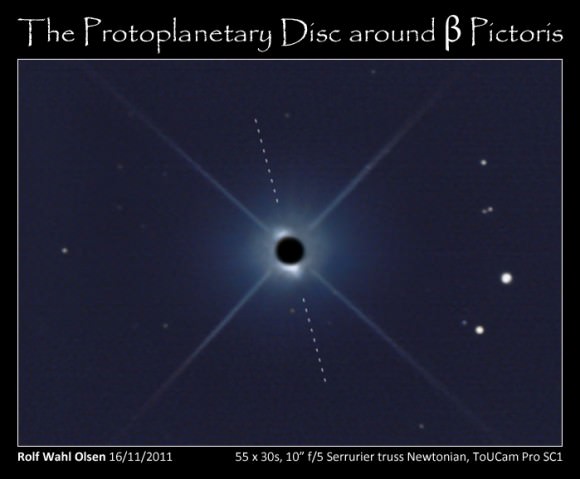Amateur astronomer Rolf Wahl Olsen from New Zealand shared an image with Universe Today, and it is perhaps the first image of another solar system taken by an amateur. The image above is Olsen’s image of the protoplanetary disc around Beta Pictoris.
“For the last couple of years I have been wondering if it was possible for amateurs to capture this special target but have never come across any such images,” Olsen wrote in an email. “I must say it feels really special to have actually captured this.”
Olsen said he has been fascinated by professional images of Beta Pictoris since seeing the first one in taken in 1984.
Beta Pictoris and the protoplanetary disc of debris and dust that is orbiting the star is 63.4 light years away from Earth. This is a very young system thought to be only around 12 million years old and astronomers think this is essentially how our own Solar System must have formed some 4.5 billion years ago. The disc is seen edge-on from our perspective and appears in professional images as thin wedges or lines protruding radially from the central star in opposite directions.
“The main difficulty in imaging this system is the overwhelming glare from Beta Pictoris itself which completely drowns out the dust disc that is circling very close to the star,” Olsen said.
Images of the disc taken by the Hubble Space Telescope, and from big observatories, are usually made by physically blocking out the glare of Beta Pictoris itself within the optical path.
Olsen found inspiration from a paper he found recently, the 1993 paper ‘Observation of the central part of the beta Pictoris disk with an anti-blooming CCD’ (Lecavelier des etangs, A., Perrin, G., Ferlet, R., Vidal-Madjar, A., Colas, F., et al., 1993, A&A, 274, 877)
“I then realised that it might not be entirely impossible to also record this object with my own equipment,” Olsen said. “So now that Beta Pictoris has risen to a favorable position in this year’s evening sky I decided to have a go at it the other day.”
He followed the technique described in the paper, which basically consists of imaging Beta and then taking another image of a similar reference star under the same conditions. The two images are subtracted from each other to eliminate the stellar glare, and the dust disc should then hopefully reveal itself.
“First I collected 55 images of Beta Pictoris at 30 seconds each,” Olsen said. “The dust disc is most prominent in IR so ideally a better result would be expected with the use of an IR pass filter. Since I only have a traditional IR/UV block filter I just imaged without any filter, to at least get as much IR light through as possible.”
The next step was to capture a similar image of a reference star under the same conditions. Olsen did as the paper suggested and used Alpha Pictoris, a star that is of nearly the same spectral type (A7IV compared to Beta’s A6V) and is also close enough to Beta in the sky so that the change in telescope orientation should not affect the diffraction pattern. However, since the two stars have different magnitudes he needed to calculate how long to expose Alpha for in order to get a similar image which he could subtract from the Beta image.
Some quick math:
The magnitude difference between the stars is 3.86(Beta) – 3.30(Alpha) = 0.56Due to the logarithmic nature of the magnitude scale we know that a difference of 1 magnitude equals a brightness ratio of 2.512. Therefore 2.512 to the power of the numerical magnitude difference then equals the variation in brightness.2.512^0.56 = 1.67, so it appears Alpha is 1.67 times brighter than Beta. This means that exposure for Alpha should be 1/1.67 = 0.597x that of Beta. I took the liberty of using 0.6x for simplicity’s sake…
“So I collected 55 images of 18 seconds (30 x 0.6) for Alpha,” Olsen said. “Both sets of images were stacked separately in Registax and I then imported these into Photoshop, layered Alpha in ‘Difference’ mode on top of Beta and flattened the result. This produces a very dark image (which it should!) apart from the different background stars. But after some curves adjustment I was able to see clear signs of the actual dust disc protruding on both sides from the glare of the star. I was very happy to conclude that the position angle with regards to the background stars matched the official images exactly.”
Olsen said he was disappointed with the raw “Difference” image so to produce a more natural looking result, he took the original stacked Beta image and then blended in the central parts from the Difference image that showed the dust disc.
“I decided to also keep the black spot of the central glare from the Difference image since the contrast with the protruding disc seems better this way,” Olsen said.
What resulted is what is thought to be the first amateur image of another solar system.
Olsen is encouraging others amateur astrophotographers to try this, and see if they can do even better.
“I’m sure this can be done much better with a higher quality camera, but at least here it is,” he said. And I’m personally extremely happy and proud of having achieved this. I hope you enjoy the view as much as I did!”
If any other amateur astronomers have attempted to image a disk around another star, we’d love to hear about it and see the results.
Check out the original image on Olsen’s website:http://www.pbase.com/rolfolsen/image/139722640/original
Source: Universe Today

No hay comentarios:
Publicar un comentario